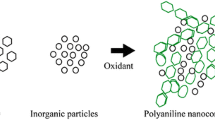Abstract
Research of conducting polymer composites has opened a wide array of possibilities to get high performance organic anticorrosive coatings, minimizing the environmental and health impact involved in many current protection systems. Polyaniline (PAni) is one of most studied conducting polymer, for different reasons, among easy processing from solutions into films, reversibly controlled electrical and optical properties. However, its mechanical and adhesion properties are poor. A path to improve PAni properties is to use an elastomer as insulating polymer matrix, as styrene-butadiene rubber (SBR). In this work, a composite from doped PAni and SBR was obtained by solution casting method, the effect of the conducting polymer/elastomer ratio and the PAni doping anion on the chemical nature and morphology of PAni/SBR composites has been studied to determine the feasibility of their application as anticorrosive coatings for carbon steel. Chemical characterization, by means of infrared spectroscopy (FTIR) and RAMAN spectroscopy, was also carried out, the presence of signals attributed to doping anion was identified in composites, also formation of ion oxides such as magnetite, hematite and maghemite were identified. Morphology of composites was obtained by means of optical and scanning electron microscopy, and allows to observe the presence of agglomerates in composites.







Similar content being viewed by others
References
Kukačková H, Kalendová A (2012) Investigation of mechanical resistance and corrosion–inhibition properties of surface-modified fillers with polyaniline in organic coatings. J Phy Chem Sol 73:1556–1561. doi:10.1016/j.jpcs.2011.11.041
Wessling B (1996) Corrosion prevention with an organic metal (polyaniline): surface ennobling, passivation, corrosion test results. Mat Corr 47:439–445. doi:10.1002/maco.19960470804
Mathew AM, Predeep P (2012) Styrene butadiene co-polymer based conducting polymer composite as an effective corrosion protecting coating. Prog Org Coat 74:14–18. doi:10.1016/j.porgcoat.2011.09.011
Tassi EL, De Paoli MA (1992) An electroactive elastomer: polyaniline/nitrile rubber. Polymer 33:2427–2430. doi:10.1016/0032-3861(92)90540-D
Gazotti WA, Faez R, De Paoli MA (1999) Thermal and mechanical behavior of a conductive elastomeric blend based on a soluble polyaniline derivative. Eur Polym J 35:35–40. doi:10.1016/S0014-3057(98)00072-X
Gazotti WA, De Paoli MA (1996) High yield preparation of a soluble polyaniline derivative. Synth Met 80:263–269. doi:10.1016/0379-6779(96)80212-8
Faez R, De Paoli MA (2002) A conductive rubber based on EPDM and polyaniline. II. Effect of the crosslinking method. Eur Polym J 38:2459–2463. doi:10.1016/S0014-3057(02)00133-7
Faez R, De Paoli MA (2001) A conductive rubber based on EPDM and polyaniline. I. Doping method effect. Eur Polym J 37:1139–1143. doi:10.1016/S0014-3057(00)00235-4
Faez R, Gazotti WA, De Paoli MA (1999) An elastomeric conductor based on polyaniline prepared by mechanical mixing. Polymer 40:5497–5503. doi:10.1016/S0032-3861(98)00775-7
Xie HQ, Ma YM, Guo JS (1999) Conductive polyaniline-SBS composites from in situ emulsion polymerization. Polymer 40:261–265. doi:10.1016/S0032-3861(98)00224-9
Leyva ME, Barra GMO, Soares BG (2001) Conductive polyaniline-SBS blends prepared in solution. Synth Met 123:443–449. doi:10.1016/S0379-6779(01)00319-8
Barra GMO, Matins RR, Kafer KA, Paniago R, Vasques CT, Pires ATN (2008) Thermoplastic elastomer/polyaniline blends: evaluation of mechanical and electrochemical properties. Polym Test 27:886–892. doi:10.1016/j.polymertesting.2008.07.004
Gomes de Souza F, Almeida M, Soares BG, Pinto JC (2007) Preparation of a semi-conductive thermoplastic elastomer vulcanizate based on EVA and NBR blends with polyaniline. Polym Test 26:692–697. doi:10.1016/j.polymertesting.2007.04.008
Österholm JE, Cao Y, Klavetter F, Smith P (1993) Emulsion polymerization of polyaniline. Synth Met 55:1034–1039. doi:10.1016/0379-6779(93)90195-3
Çolak N, Sökmen B (2000) Doping of chemically synthesized polyaniline. Desig Mono Polym 3:181–189. doi:10.1163/156855500300142870
Willis JN, Liu X (1994) A study of styrene butadiene rubber using GPC-FTIR. In: International GPC symposium. Waters Corporation, Florida
Litvinov VM, De PP (2002) Spectroscopy of Rubb Rubb Mat. Rapra Technology Ltd, Shawbury, United Kingdom
Atassi Y, Tally M, Ismail M. (2008) Synthesis and characterization of chloride doped polyaniline by bulk oxidative chemical polymerization. Doping effects on electrical conductivity. arXiv:0809.3552
Yelil Arasi A et al (2009) The structural properties of poly (aniline)—analysis via FTIR spectroscopy. Spectrochim Acta A Mol Biomol Spectrosc 74(5):1229–1234
Silverstein RM, Morrill TC, Bassler GC (1974) Infrared spectroscopy. In: Robert M. Silverstein, G. Clayton Bassler, Terence C. Morrill (eds) Spectrometric Identification of Organic Compounds, Wiley
Prasertsri S, Lagarde F, Rattanasom N, Sirisinha C, Daniel P (2013) Raman spectroscopy and thermal analysis of gum and silica-filled NR/SBR blends prepared from latex system. Polym Test 32:852–861. doi:10.1016/j.polymertesting.2013.04.007
Trchova M, Morávková Z, Bláha M, Stejskal J (2014) Raman spectroscopy of polyaniline and oligoaniline thin films. Electroch Acta 122:28–38. doi:10.1016/j.electacta.2013.10.133
Li Y, Church JS, Woodhead AL (2012) Infrared and raman spectroscopic studies on iron oxide magnetic nano-particles and their surface modifications. J Magn Magn Mater 324:1543–1550. doi:10.1016/j.jmmm.2011.11.065
Acknowledgments
The authors would like to thank Dirección General de Educación Superior Tecnológica (DGEST) and CONACYT for financial support, code 5015.13P and No. 177480, respectively. One of the authors (CMDLA) thanks CONACYT No. 490946/279281 for fee scholarship.
Author information
Authors and Affiliations
Corresponding author
Rights and permissions
About this article
Cite this article
De León Almazán, C.M., Chávez-Cinco, M.Y., Páramo-García, U. et al. PANI/SBR composites as anticorrosive coatings for carbon steel I. Chemical, morphological and superficial characterization. Polym. Bull. 73, 1595–1605 (2016). https://doi.org/10.1007/s00289-015-1565-3
Received:
Revised:
Accepted:
Published:
Issue Date:
DOI: https://doi.org/10.1007/s00289-015-1565-3




